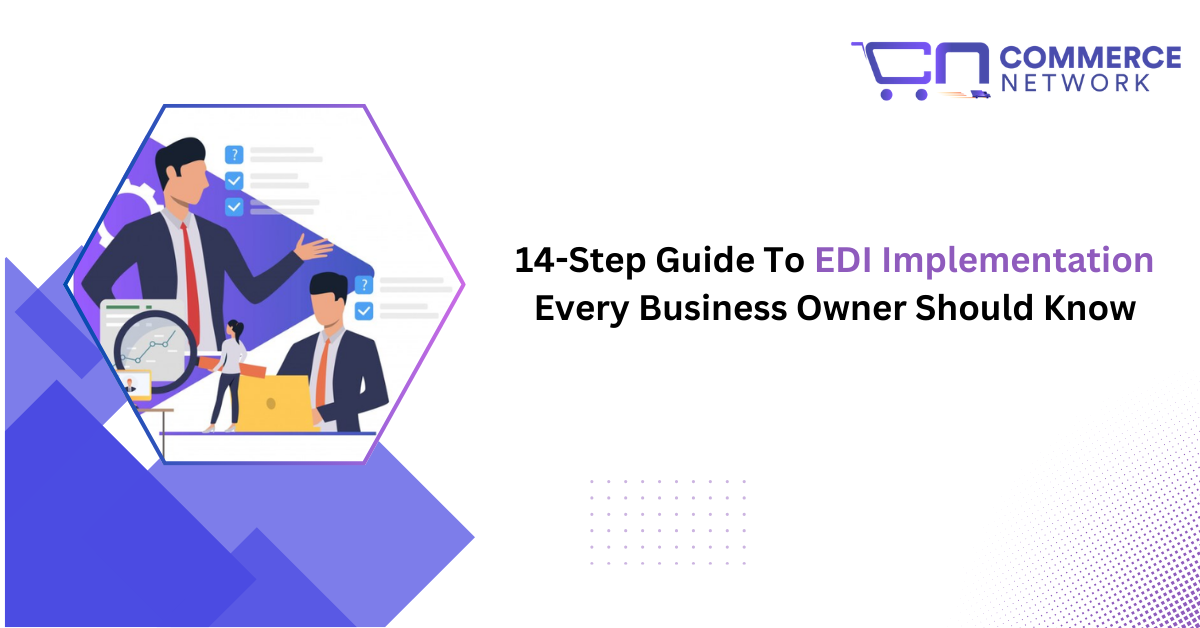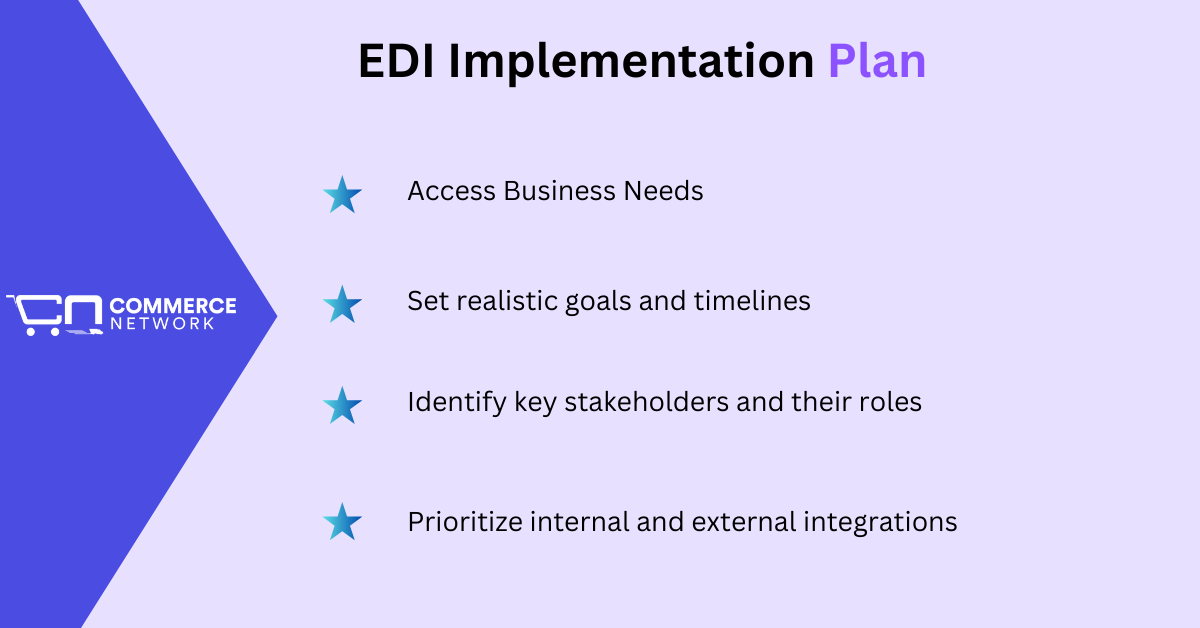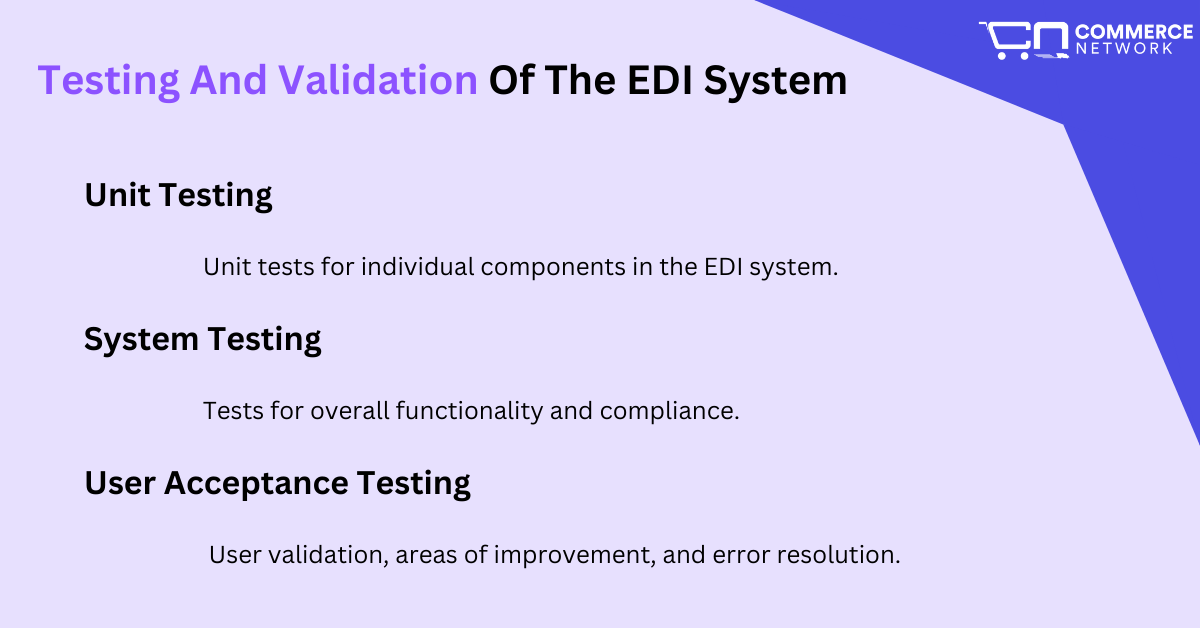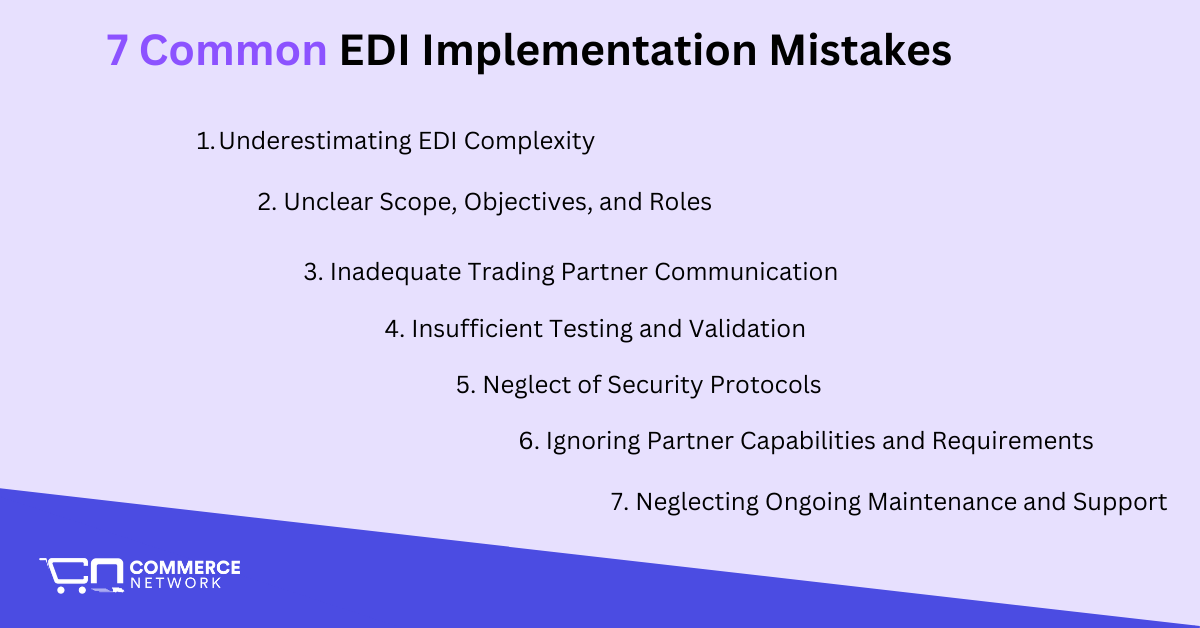
Modern business systems emphasize heavily on efficiency. Electronic Data Interchange (EDI), by reducing costs, enabling faster transactions, and improving collaboration, has become a critical tool in a supply chain.
From retail, healthcare, transportation, and logistics, to IT, finance, and manufacturing, EDI is being implemented in every industry.
However, implementing an EDI solution is not simple.
If you are a business owner trying to adopt EDI in your system, understanding its implementation process is essential for seamless integration into existing workflows.
This 14-step guide will help you navigate through the implementation requirements, choosing the right provider, standards setup, testing plans, onboarding, and more so you can solve the complexities of EDI implementation and maximize the potential of this powerful technology.
Every implementation step starts with a plan. You start by accessing your current business needs, identifying key areas for EDI implementation, and setting goals and timelines.

Start by accessing your business needs factoring in these considerations:
Accessing your needs and resources helps align your requirements for EDI with your business objectives.
Set realistic goals and timelines.
Your goal for implementing EDI can range from improving accuracy, enhancing collaboration, or just sending and receiving data electronically.
Set realistic goals and expectations that can be achieved within a specified timeframe for smooth progress.
For example: You cannot set the deadline for EDI implementation of 1 week if you are a business with many trading partners, a large volume of transactions, and a complex ERP system.
Identify key stakeholders and their roles in the implementation.
Decision-making, collaboration, accountability, and smooth operations depend on whether each party involved in the implementation process clearly understands his/her role.
Find key individuals for implementation like business owners, project managers, EDI coordinators, IT staff, accounts managers, etc., and specify clear goals for each of them during and after implementation.
Prioritize internal and external integrations.
Prioritizing the internal and external integration components includes which business component integrates with EDI first and which goes later on.
For example, a business with an urgent need for batch processing data exchange may need to prioritize implementing EDI within its inventory management and accounting before integrating with systems like CRM.
Many forget this step, which makes the implementation process more complex later down the line.
Implementation of EDI has several requirements that must be met. These requirements come in the form of hardware, software, and technical requirements.
Hardware requirements: Consists of a company’s hardware infrastructure like computer hardware, workstations, databases, and servers as well as their availability.
Software requirements: This consists of the software required for implementing EDI. They can be mapping software, translation software, cloud computing software, and communication software.
Technical requirements: Technical requirement consists of the network required for data transmission and the technical expertise of staff for EDI implementation and operation.
Technical requirements can also include peripheral requirements like Virtual Private Networks (VPNs), Value Added Networks (VANs), or security requirements.
Specific requirements depend on your business resources, goals, and end objectives.
A small business that only requires a small EDI team for data exchange will clearly have fewer requirements than a large enterprise that needs EDI for many different tasks.
Solving the EDI implementation requirements involves adding in budgets, maintaining or improving your office IT infrastructure, and hiring technical staff for EDI training and operations.
Only by solving the requirements can you truly be poised to implement EDI in your system.
This is the most critical step in implementing EDI. The type of solution your business needs varies between two types: on-premise and outsourced solutions.
Each has its distinct advantages and disadvantages. You should choose the optimal solution depending on what the solution can do for your business’s EDI goals.
Here is a small comparison table comparing an On-premise EDI solution and an Outsourced Solution.
|
Evaluation Criteria |
On-Premise EDI Solution |
Outsourced EDI Solution |
|
Technology |
Uses on-premise hardware, software, and staff for EDI. |
Uses third-party EDI providers with technologies like cloud computing to provide EDI services. |
|
Cost |
Requires higher costs for training, hardware, and software installations. |
Less costly compared to on-premise solutions and primarily uses subscription or transaction volume for charges. |
|
Best For |
Large businesses with complex EDI requirements and who can provide the cost for resources and training for staff. |
Best for small and medium-sized businesses with less complex EDI needs and who are on a budget. But can be used by large businesses with scalability. |
|
Scalability |
Offers less scalability than outsourced providers. |
Offers more scalability than on-premise solutions. |
|
Flexibility |
Higher flexibility as a business can modify the solution depending on changing needs. |
Less flexible as standards, requirements, and data sets are preset. |
|
Accessibility |
Less accessibility. Requires one to be present on company grounds or near the hardware infrastructure. |
High accessibility by providing the option to access the solution from anywhere and at any time through an internet connection. |
|
Maintenance |
Costs a lot to maintain as it requires staff training, and hardware and software updates. |
Cost-effective maintenance as the providers handle all maintenance-related tasks. |
If you go with an on-premise solution, you will have full control over the implementation process, training guidelines, compliance standards, mapping, translation and transmission tools, and the overall implementation process.
However, if you opt for an EDI provider because you value scalability, cost-effectiveness, and efficiency, there are certain considerations you should be aware of.
As not all implementation and operational processes of EDI will be under your control with an outsourced EDI solution, you need to look for certain features in an EDI provider.
Features to look for in an EDI provider
The next step is to build your EDI team. Whether you are using on-premise or outsourced EDi service, the significance of your team is critical.
The size of the team can vary with in-house solutions requiring larger teams than outsourced.
Building a strong team requires proper communication between all involved parties. You must assign adequate roles and responsibilities to the IT staff, EDI coordinators, and project managers.
Partnering with consultants for managed EDI services through providers is also essential to track your EDI operations.
With proper partnerships, the EDI consultants can point out the flaws and areas of improvement in your EDI processes and also help address issues that crop up.
Collaboration with trading partners during implementation is another process in this step. Open communication with trading partners ensures mutual understanding of requirements and smoother integrations.
Standardization is a key step in implementing EDI. This step answers the questions of what types of documents are exchanged, communication protocols, and compliance guidelines.
Depending on your industry and needs, you should choose the EDI document standards like ANSI X12, or EDIFACT. Once the structure of EDI documents is defined through standards, translations, mapping, and eventual transmission becomes much more convenient.
Communication protocols are another major aspect of EDI document exchange. AS2, FTP, SFTP, etc. are some protocols that ensure that data transmitted to and from your solution remains secure.
You should take into consideration the security environment within your industry, your business systems, and trading partner preferences while setting up the communication protocols.
For example, if you are a business related to healthcare, you need to set up a secure EDI protocol so that sensitive patient information cannot be lost, damaged, or hacked during transmission.
You should also add guidelines for encryption, authentication, and access control in your system during this implementation step.
Who can access the EDI data, how much can one access it, what encryption and decryption keys are being used, who has access to those keys, and what additional security measures are taken to safeguard the hardware and software implementing EDI are some security factors to consider.
In this step, you align the data formats used by your internal business systems like ERP and CRM with appropriate EDI standards.
For example, the data uploaded on your inventory management system about an order of purchase needs to be translated to a Purchase Order (EDI 850) for transmission.
Mapping specific fields and ensuring compatibility are the main challenges of translations. You can use automated tools like AI to streamline data mapping and repetitive tasks like data entry.
But perform manual checks again and again to ensure accuracy in complex scenarios (e.g. translation of multiple documents with different mapping fields simultaneously).
Another aspect to consider is the handling of exceptions and edge cases. Oftentimes, exceptions and anomalies occur while translating and processing EDI documents.
They can range from missing fields to unexpected data formats. So, you should develop proper contingency plans and guidelines for handling these anomalies.
If done incorrectly, this step can cause many problems during EDI transmission like conflict in data formats, mapping errors, inconsistencies in data values, and inefficient data transmissions.
However, the upside is that if done correctly, this step ensures a very smooth EDI document flow.
After mapping and translations are completed, it is the turn to actually integrate your internal business systems with the EDI solution.
Integrating EDI with current systems running in the business can be categorized into three processes.
1. ERP, WMS, CRM, and Accounting system compatibility.
Write codes to integrate EDI with ERP, WMS, CRM, Accounting, and related business systems. Make sure that all errors are properly handled.
Also, ensure that the integrated system is compatible with EDI standards and formats for automation and document exchange.
2. API or middleware solutions for seamless integration.
APIs are integral if you want to incorporate modern automation techniques into EDI systems. They provide real-time data exchange across diverse formats unrelated to EDI standards.
So, integrating API or middleware is essential if you want to perform data exchange with EDI as well as other formats like JSON, PDF, and more.
Middleware software bridges gaps between EDI systems and legacy software, enabling smooth communication.
3. Challenges in legacy system integration and solutions.
Many EDI standards, formats, and processes have been for a long time. These legacy systems often lack modern integration capabilities.
Addressing these challenges with API integrations, middleware support, and customization is crucial while integrating EDI with business systems.

After mapping, translation, and integration are done, it is time to test your system.
Creation of a comprehensive testing plan, implementation of that plan, and performing tests on the integrated EDI system are extremely important.
Conduct a thorough testing of all systems using Unit, System, and User Acceptance testing.
You also need to conduct test transactions in a simulated environment with trading partners. This gives you a complete picture of how the system behaves in a real-world environment.
The primary reason for testing is to find errors, and compliance issues, and fix bugs before the system goes live.
With proper testing mechanisms, large numbers of errors can be minimized, and disruptions can be identified and addressed so that live operations of the EDI functions can be smoothly performed.
Onboarding trading partners to use your EDI solution is the next step in implementing EDI.
To ensure smooth operations when you send and receive EDI documents from trading partners, it is critical to onboard them into your EDI system.
The onboarding process involves clear communication, coordination, and alignment of EDI standards and formats between your system and the trading partner system.
You begin the onboarding process by setting up agreements with your trading partners. They are called Trading Partner Agreements (TPA).
A TPA essentially outlines the expectations, data formats, compliance standards, and communication protocols that are to be used between two systems.
Consider this: You are a retail company onboarding a supplier for EDI.
You and your trading partner (i.e. supplier) agree on using ANSI X12 format for documents like purchase orders (EDI 850) and invoices (EDI 810). You also define communication protocols, such as using AS2 for secure data transmission.
During the onboarding process, specific customization may be needed. For example, you require the supplier to include additional data fields in the purchase order, such as a unique store identifier.
Your EDI system now maps these fields to align with your supplier’s ERP system. Then, you test the EDI operation by sending a test purchase order to your supplier’s system and the supplier sends a test invoice to your system.
If the test passes, it is understood that the EDI system of both parties complies with each other. If the test fails, you need to realign the mapping fields, data standards, and protocols until the transaction is smoothly carried out.
You must communicate with your trading partners regularly throughout the onboarding process to address queries, resolve technical challenges, and maintain compliance while implementing EDI.ndards.
Training and documentation are key to ensuring all users understand and efficiently manage EDI processes. The process includes creating guides, training users, and establishing a support system.
Creating User Manuals and Technical Guides
User manuals should outline workflows for sending, receiving, and troubleshooting EDI documents.
You may create a user manual on using your EDI system for your trading partner. Or you may create a guide on using the system for your internal teams.
Example: a guide for submitting invoices (EDI 810) may include step-by-step instructions, common errors, and resolution methods.
Technical guides for IT staff focus on system setup, data mapping, and compliance standards.
For an outsourced solution, documentation may prioritize portal usage and task-specific instructions, while in-house EDI guides include system configuration and maintenance details.
IT teams receive training on system integration, data mapping, and troubleshooting.
As an example, your IT team might learn to resolve mapping errors in Purchase Orders (EDI 850) while the end-users are trained on how EDI integrates into their tasks, such as processing Advance Shipping Notices (EDI 856).
Training may vary based on the setup—in-house systems require deeper technical training for IT staff, whereas outsourced solutions focus on user-centric tasks.
A helpdesk handles ongoing issues. In in-house setups, the company manages support, while outsourced providers offer dedicated help for technical concerns.
After partner onboarding, testing, training, and creating guides for operation, it is finally time for your EDI system to go live.
There are mainly two approaches to going live with EDI; namely the gradual rollout and the big-bang approach.
Deciding which one to choose for rollout depends on a multitude of factors like number of trading partners, transaction volumes, the complexity of processes, and risk tolerance.
Basically, if you are a business with many trading partners and complex EDI setup, gradual rollout suits you while small networks with less complex processes requiring fast implementation generally take the big-bang approach.
Here is a detailed comparison of the two so you can better decide which one to choose for your implementation.
|
Terms |
Gradual Rollout |
Big-Bang Approach |
|
How It Works |
EDI is implemented in phases. You start with a subset of trading partners or document types and gradually expand over time. |
Involves transitioning all trading partners and EDI processes simultaneously on a set go-live date. |
|
Benefits |
|
|
|
Drawbacks |
|
|
|
Example |
You are a retailer implementing EDI.
You first onboard a small group of key suppliers for Purchase Orders (EDI 850) and Invoices (EDI 810).
After successful testing and live transactions, you progressively add other suppliers and documents like Advance Shipping Notices (EDI 856).
|
You are a manufacturing company.
You decide to go live with all suppliers and documents, including Purchase Orders (EDI 850), Invoices (EDI 810), and Shipping Notices (EDI 856), on a single day after thorough preparation.
|
Once your EDI system is live, ongoing maintenance is crucial to ensure it continues to run smoothly and meets your business needs. Here’s what you need to focus on:
You’ll need to keep your EDI software updated with the latest patches and upgrades.
You need to talk to the EDI providers about the status of their system and upgrade process if you are using an outsourced solution.
This ensures your system remains secure, performs optimally, and stays compatible with your trading partners' platforms.
For example, updating to the latest EDI standards like ANSI X12 or EDIFACT can help avoid communication issues.
It is important to regularly monitor your EDI transactions to catch and fix issues such as data mismatches or failed transmissions.
For instance, if you notice errors in Acknowledgments (EDI 997), it could signal a problem in the data flow that needs immediate attention to prevent disruptions in your operations.
As your system stabilizes, consider extending its usage to more trading partners or adding new document types.
By staying proactive with maintenance, you’ll ensure your EDI system remains reliable, scalable, and efficient for your business growth.
Ensuring constant EDi compliance with industry regulations and trading partner standards is another job to do after EDI implementation. This is an ongoing process that simply cannot be missed.
You need to consistently meet trading partner requirements. The requirements can often change, making it a challenge to meet them.
Moreover, you need to constantly adhere to industry standards and regulations while maintaining compliance with trading partners.
This requires a significant effort by your in-house staff. A provider provides all these services as a part of their packaged solution. However, your EDI team must constantly monitor for any issues.
Regular performance checks and swift issue resolution help keep operations running smoothly while compliance with industry standards like HIPAA safeguards your business integrity.
You also need to implement encryption, firewalls, and multi-factor authentication to your business systems integrated with EDI to protect against potential data breaches.
This is the final step of this guide. In this step, you will start thinking about scaling your implemented EDI solution.
There are several ways to scale your solution like adding new EDI documents, collaborating with more trading partners, automating additional workflows, and enabling advanced features in your solution.
As your business grows, your old system becomes incapable of handling the requirements of EDI transactions. You also need to add more partners and document types for efficient communication across your diverse supply chain network.
You can also start exploring advanced features in modern automation systems like AI tools for error prediction, analytics, and enhanced decision-making.
Many businesses overlook some common things while implementing EDI. This complicates the entire implementation infrastructure.
So, here are 7 common mistakes that you, as a business owner, must avoid while implementing EDI. Avoiding these mistakes are key success factor for smooth implementation.

Because underestimating EDI results in errors, delays, cost overruns, and inefficient implementation.
As a business owner, it is critically important that you understand that EDI implementation is a highly complex process involving multiple document types, trading partners, compliance standards, etc.
While having an outsourced provider does lessen complexity to a large extent, you must not get unfocused and leave everything to the providers. Instead, actively participate in every part of the process to ensure smooth implementation.
Without defining the scope, objectives, and roles, the team implementing EDI might get sidetracked, miss requirements, and take up unnecessary time and cost resources.
So, define clear objectives and roles for smooth resource allocation, timeline planning, and budget management.
You need to avoid this by communicating with your partners whenever needed without missing out.
Ineffective communication is often the source of misunderstandings, delays, and poor relationships, severely impacting your implementation and eventual operation of EDI.
Many do not fully understand this and start using their EDI solution in a live environment thinking simple tests are sufficient (which they are not).
Insufficient testing creates unnecessary errors, increases disruptions, and hampers the smooth operation of data exchange via EDI.
This is something you actively need to avoid at all costs while implementing EDI.
So, adopt strong security measures with encryptions, firewalls, and protocols to protect against data breaches and unauthorized access.
Your trading partners may not have the same resources, compliance standards, capabilities, or limitations as you do.
You must always try to understand the specific EDI needs and requirements of all of your trading partners.
So, coordinate with trading partners on specific requirements, timelines, and goals.
Get a dedicated team to constantly monitor, maintain, and operate your system and adequately address any concerns or issues the team may bring to your attention.
EDI implementation is a transformative process that requires careful planning, collaboration, and ongoing optimization. By following the outlined steps and focusing on scalability, compliance, and training, businesses can harness the full potential of EDI to streamline operations and enhance competitiveness.
Improve Your B2B, B2G, and B2C Ecommerce?
Integrate EDI For Efficiency, Compliance, and Scalability?
Just Curious About EDI?
Give Us A Call
202-280-7060